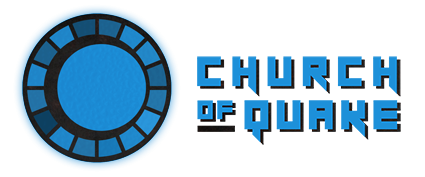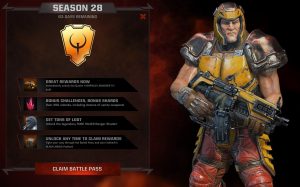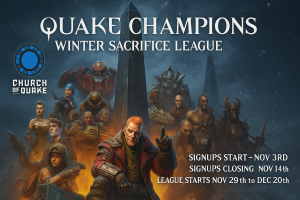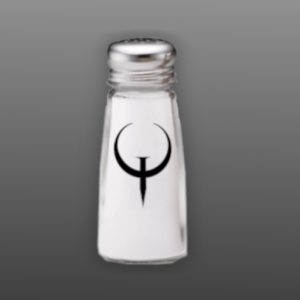Guide Written by Yakumo, originally posted on the official forums
While Quake Champions is still in production there is a lot of work being done that can effect performance, client issues can greatly effect this as well so here are some steps you can take to help ensure that your own system is as tuned up as it can be for the best possible experience.
Each section is being added after it’s been noted that it can have a noticeable effect on game performance, though there is no guarantee your own specific issues may be solved, following all of the sections would ensure you have eliminated known sources of problems.
If these suggestions do not help do please create a support ticket on http://help.bethesda.net/ both to get assistance for yourself and so that the issues are logged for investigation by the developers.
The numbered sections are in order of how time consuming they are to do, shortest first.
1. Reset GPU Driver Profile
For Nvidia Users:
- Nvidia Control Panel
- In Manage 3D settings
- On the Global tab hit the restore button to reset the global profile to defaults
- Check ‘DSR Factors’ are all set to OFF (prevents rendering at higher than screen resolution)
- On the Program Settings tab hit the restore button, and on any specific Quake Champions profile you have
- In Manage 3D settings
For AMD Crimson users:
- Under Gaming
- Use the reset button top left to reset global profiles to default
- Remove any Quake Champions profile and recreate a clean one.
2. Nvidia Quake Champions GPU Profile
In your Nvidia Control Panel -> Manage 3D settings -> Program Settings, create a driver profile for Quake Champions and set:
- Anti aliasing mode – you can set this to off to gain a little performance at cost of image quality but QC currently seems to reset it when you visit settings pages again.
- Pre-rendered frames 1 or 2 (test for personal preference, 1 gives the lowest possible input lag, 2 may be smoother)
- Refresh rate – highest available (optional but can solve the game not choosing 120 or 144hz).
- Threaded optimisation on or off (test as this is system specific, on usually gives better frame rate, off has been know to cure a severe input lag issue on some systems)
3. Reset Quake Champions Config
Take note of your in game settings especially any mouse settings and fov, and wipe following folders to clean the game’s configuration, this can currently have a marked improvement on frame rate on some systems with old config files. It should be also be considered after game or driver updates, especially if a drop in performance is noted.
Copy and paste the following locations into Windows File Explorer address bar (or winkey-r but you will have to remove the quotation marks) if any of the folders exists rename or delete them for the game to recreate defaults:
%LOCALAPPDATA%\id Software\Quake Champions
%LOCALAPPDATA%\Saber
%LOCALAPPDATA%\Saber Interactive
(will only exist for former beta testers)
4. Clean Graphics Drivers
AMD and Nvidia users should consider using Display Driver Uninstaller (DDU) in Windows Safe Mode to wipe your graphics drivers completely removing all traces of past installs, and then install the latest from nvidia.com or amd.com (not opting to accept cookies may cause scrolling the page to fail)
5. Update Operating System
Check Windows (Start) button -> Settings -> Updates and Security (windows update on older systems) and hit ‘check for updates’, ensure you have all updates installed.
Consider upgrading to Windows 10 v1809 “October 2018 Update” especially if currently using Win10 v1703 “Creators Update” as that version has specific stuttering bugs in many games which Microsoft has sought to address with later versions (source).
You can force an upgrade, download an ISO or build a USB memory stick to upgrade or install clean via https://www.microsoft.com/en-gb/software-download/windows10.
After install it is recommended to then follow the instructions above in the Clean Drivers section to DDU wipe and then install the latest GPU drivers, as windows updates often install driver versions that cause major problems for games.
*Disclaimer*
Driver and software updates, Windows updates and the use of uninstall tools are taken entirely at the users own risk, and subject to the disclaimers of the driver, update or uninstall tool authors. Should any problems occur with the process the support of the tool or update’s author should be sought.
6. The Windows Page File
It is a myth that disabling the Windows page file gains performance, Windows attempts to flush out to the page file when things are idle, leaving more system ram free to be used by active applications thus letting them perform well or in some cases – at all. The other main uses for the page file is only if an application attempts to exceed the amount of physical ram in the system it will fail over to the page file, this is slower than system ram but at least still allows the operation to complete instead of the program throwing an error or closing in best cases, or simply crashing in the worst. For these reasons some applications suggest or even require that the page file is enabled.
There is an article on the page file by Microsoft’s Mark Russinovich on their Technet blog – Introduction of page file , or Mark also wrote Pushing the Limits of Windows: Virtual Memory, which covers the subject in depth, but the basics are:
- The system memory commit limit is RAM + page file – a small overhead.
- The system commit charge is the amount of ram committed (promised) to the system and all processes running on the system
- The system commit charge can exceed physical ram, but if it approaches the commit limit the system and running processes may not get committed memory, and can this “can cause freezing, crashing, and other malfunctions”.
The simplest solution for users is to ensure that at least one partition on their system is set to System Managed for the best performance and importantly stability of their games.
There have been several users who reported game crashes, even with significantly more ram than required (32GB), who found that re-enabling a page file on their system solved their stability issues.
7. System Memory
- Quake Champions benefits from high memory bandwidth, do check if you have two physical sticks of memory that they are running in dual channel mode by being in the correct slots on your motherboard (cpu-z will inform you on the memory tab if dual channel is enabled), if you only have one memory stick, adding a second in order to enable dual channel mode as well as increase your systems capacity can make a noticeable difference.
- Overclocked memory is often the cause of system crashes, if you are overclocking your ram, it is vital that you try testing with no overclock as well. If one application is crashing or bringing down the whole system when you’re overclocked but stable when not overclocked, no matter what that application is then the ram has been pushed too far and the overclock is the issue resulting in memory errors or overheating.
8. Windows Game Bar/Game DVR/Game Mode
Windows Game Bar and Game DVR can negatively affect performance, they are especially unneccessary if you already use Nvidia Geforce Experience or AMD Replay to record game clips.
Windows Game Mode has been shown to also cause performance issues including lower minimum FPS drops on very powerful systems in independent reviews, such as by Linus Tech Tips here, as such I would recommend not enabling it especially if you are interested in streaming as it will take resources away from your streaming software.
Windows (start) button -> settings -> gaming
Game Bar – “‘record game clips ….. ” : OFF
Game DVR – “record in the background while I’m playing” : OFF
Game Mode – “Use Game mode” : OFF
NB. the global Game Mode option here is no longer an option in Win10 v1709 Fall Creators Update, and can only be configured per-application via first enabling the Game Bar globally and then running the application you wish to set it for, then opening the Game Bar with WinKey+g with the application and selected. It is off by default for all applications/games.
It is also beneficial to tick “Disable full-screen optimization” found via right click quakechampions.exe -> properties -> compatability. This is only an option in Windows 10 v1706 “Creators Update” (RS2) and newer. If left enabled this mode is known to run applications in a form of borderless window even when fullscreen is selected, disabling ‘Game Mode’ globally used to disable screen optimization globally but in win10 v1709 that is no longer an option.
While some of these settings could be set per-application via the Game Bar, it wasn’t until I forced the game bar itself off also that I gained a considerable amount of FPS back (~40fps in one particular set of CBT builds ) , and was able to stream using OBS and nvec with only a 2-3 fps drop. the Fall Creators Update improved the situation but with the majority of resources being diverted to the game a large amount of audio desync was common when streaming with OBS, as of Windows 10 build 17763.404 released just hours before I made this edit that may be a fixed issue however as it contains the patch note : “Includes a fix for Game Mode that ensures the feature will no longer impact your experiences when using the industry’s top streaming and recording software.”
Windows Power Profile
Press Winkey+r, enter powercfg.cpl and hit enter.
If your Power profile is set to ‘balanced’ you are very likely to have frame rate performance issues in game, you should set this to ‘high performance’ instead at least when intending to play.
10. Systems with multiple GPUs in SLI
Users with SLI configurations should disable all but one card on SLI systems, Quake Champions doesn’t support SLI at this time, and a number of users have reported that average FPS was unchanged, but micro stuttering and/or input lag was vastly reduced by disabling one card in the Nvidia Control panel. I have not heard from any AMD Crossfire users at this time, but I would certainly test this as well if seeing issues.
11. Clear DirectX Shader Cache
If you are having problems with games taking a very long time to load even on an SSD, do ensure that your shader cache is not disabled for the game in your graphics card driver. On AMD systems especially there was a driver bug that limited the size of cache files to 64k, this has caused some severe loading issues for some users. You can fix this without reinstalling or rebooting by
- Hit your windows key to open the start menu,
- Type ‘clea’ and select ‘Disk Clean-up’ , it will give a UAC prompt you will need to accept,
- Once the program has opened deselect all of the tick boxes except ‘DirectX Shader Cache’ which should be ticked (you don’t have to deselect the rest, but it might take a long time if you don’t) and then hit ok.
12. Set Game Process Priority
This is more of a tweak than I had originally intended to include, but for those having frame rate problems since the last update, setting the game process to high priority can alleviate this a fair bit, but usually this has to be done manually on every load.
This registry file can be opened to add a key to your windows registry that will make it a permanent setting. A second reg file to remove the keys and return it to default has been included.
Running registry files requires administrator access. This change is done at your own risk, check the contents of the files by opening them with a text editor.
set high priority –
Windows Registry Editor Version 5.00 [HKEY_LOCAL_MACHINE\SOFTWARE\Microsoft\Windows NT\CurrentVersion\Image File Execution Options\QuakeChampions.exe\PerfOptions] "CpuPriorityClass"=dword:00000003
remove the modification –
Windows Registry Editor Version 5.00 [-HKEY_LOCAL_MACHINE\SOFTWARE\Microsoft\Windows NT\CurrentVersion\Image File Execution Options\QuakeChampions.exe]
Download the files here: http://s000.tinyupload.com/ind…







